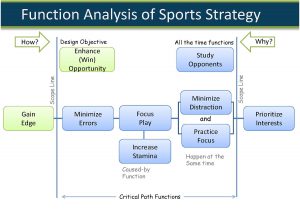 Ken Holt of Alfred Benesch & Company and I have created two fictional characters named Ben and Ash. Ben and Ash are going to chat about various cases of function analysis perspective in the upcoming issues. Ben is very experienced and has in-depth knowledge of the Value Methodology. Ash is a new-comer and trying to learn while challenging Ben. They assume different characters in various discussions. You will enjoy their conversations in every issue.
Ken Holt of Alfred Benesch & Company and I have created two fictional characters named Ben and Ash. Ben and Ash are going to chat about various cases of function analysis perspective in the upcoming issues. Ben is very experienced and has in-depth knowledge of the Value Methodology. Ash is a new-comer and trying to learn while challenging Ben. They assume different characters in various discussions. You will enjoy their conversations in every issue.
By Muthiah Kasi, PE, SE, CVS-Life, FSAVE
“A strategy describes how the ends (goals) will be achieved by the means (resources). This is generally tasked with determining strategy. Strategy can be intended or can emerge as a pattern of activity as the organization adapts to its environment or competes. “…strategy is about shaping the future…” and is the human attempt to get to “…desirable ends with available means…”. [“Strategy” in Wikipedia. Retrieved August 16, 2016]
Use the FAST diagram as a reference in following the conversation shown below. The purpose of the conversation is to illustrate how a FAST diagram is developed as the strategy evolves. Ash implies how he illustrated the “How?” path to the tennis players and what he expects them to do. He didn’t stop there. He used the “Why?” path to convince them.
The following conversation illustrates how important the objective is and that it needs to be defined, understood and communicated. If the coach accepts the objective of what the players want (Facilitate Win) it shifts the accountability to the coach. If the objective is changed to Facilitate Opportunity, it spreads the responsibilities among the coach and players. It is a strategic approach for a better result.
Ben reminds the frustrated coach that playing the role of a seller is equally as important as being a doer or instructor. The coach convinces the players that in order to Focus Play you need stamina. The function Increase Stamina is identified as a caused-by function to satisfy the function Focus Play.
Among the functions, one function is usually a standout to feel the trend for success. This is the Key Performance Indicator (KPI). In this case, the coach felt that if they don’t prioritize interest, nothing is going to help the objective. The causative function, in this case is the KPI.
Lastly, varying the verb of a function yields a different strategy. Minimize distortion is a task the players expected to manage themselves. When it is beyond their control, they need to learn to accommodate distraction. This means they will Practice Focus in a different way. Often transportation engineers need a different strategy with the functions Reduce Traffic, Prohibit Traffic or Maintain Traffic.
Now follow the conversation to appreciate the importance of the HOW?-WHY? critical path.

A conversation between Ben, the VE Specialist, and Ash, the Tennis Coach.
[Ben walks up to Ash on the court as the last of his students are leaving after practice.]
BEN: How’d practice go today?
ASH: Same thing every time. These kids are killing me! They expect me to say the magical words that automatically allow them to win. And, any time they lose they throw all the blame on me. No, nothing to do with their lack of practicing and terrible commitment, it’s clearly just my inability to make them winners.
BEN: Woah, slow down there buddy. First of all, it is not your job to make them winners.
ASH: Right?
BEN: Your job is to create or improve an opportunity for your students to win. Not hand them a victory on a silver platter.
ASH: Well, if they want a for-sure victory I could always do what some coaches do and supply them with performance enhancers.
BEN: Ha. Well, they’re still in the Olympics. Can you believe that?
ASH: Well, my kids aren’t on that level right now so no need to dope them yet.
BEN: Ha ha.
ASH: Look, they are not competing for Wimbledon, but I do want them to win and to give them the skills and chance to compete for Wimbledon if that’s what they want.
BEN: Ash, you need to make it clear to the players that your objective isn’t to facilitate or guarantee a win. If that’s the way they are thinking about it and they don’t win they are just going to blame you. Your job is to create a situation for them to have a chance to compete.
ASH: And I do that, but they’re constantly distracted. And because of that they constantly make errors. Simple mistakes that I keep going over and over with them. Then on top of that they all eat poorly which tires them out quicker and at that point all focus is gone.
BEN: Ok? Well, what’s distracting them? Have you thought about taking their gadgets away?
ASH: It’s not my job to confiscate their personal property, Ben. When they are here they should want to learn instead of playing on their Street Pass or Pokemon Go or whatever.
BEN: Ooh, I downloaded Pokemon Go the other day. It’s great.
ASH: Oh yeah, I downloaded it too. Love it. I’m not saying they shouldn’t have these distractions – it’s important to relax and decompress. But when they are here I want them to make practice the number one priority. How do you do it?
BEN: My goal is to “Enhance Opportunity” to win (uses air quotations). It is their job to take advantage of the opportunity that I create for them.
ASH: What was that (mimics air quotes)? What are you doing?
BEN: “Enhance Opportunity”? It’s a part of a diagram that I created to help achieve objectives for athletes. I call it the FAST diagram. Function Analysis of Sports Strategy (FAST).
ASH: Ha, got it.
BEN: It sounds like you have repeated the HOW part of the logic diagram, but your students don’t know the WHY part.
ASH: I think you’re going to need to walk me through this.
[A few weeks later, after Ash has grasped the FAST diagram that Ben taught him, his players are showing signs of improvement. The players have grasped the HOW-WHY logic of the critical path functions with the objective cleared.]
ASH: I did it! They are finally on the right track. They’ve agreed to put all activities to help them win as a priority. And more importantly, they’ve agreed to stop catching Pokemon during class!
BEN: Look at you, looking like a real coach more and more.
ASH: Yesterday every single kid turned off their phone and threw them in their bag. They were being respectful of the function “Prioritize Interests”.
BEN: Already catching onto the lingo? Alright! FAST really stuck with you, didn’t it?
ASH: Yes it did! The other day I even mentioned eating habits to help increase their stamina. So they’re now all on a health kick! It’s great. They’ve been eating more bananas and fish. They are even eating kale!
BEN: You know, I really don’t understand kale.
ASH: Yeah, me neither.
BEN: This is great! They are now creating more opportunities to win. And now that they are making tennis a priority, everything will flow. The function of making it a priority is a Key Performance Indicator, a “KPI” (uses air quotes).
ASH: There’s those air quotes again. KPI wasn’t on the FAST diagram you showed me.
BEN: No, no. The Key Performance Indicator is just some action or function that indicates that they are working towards the objective. Using the FAST diagram helps to understand the issues and to focus on the KPI. The KPI is just the strategic approach to critical thinking. So making tennis a priority, or rather Prioritize Interest, is a Key Performance Indicator. So, for critical thinking the strategist, aka you the coach, need to locate the KPI’s for your students.
[A few weeks later]
BEN: So how has the coaching biz been going, Ash?
ASH: So far really great! Everyone has been working on their objective. Although one of the kids has had some family issues. He hasn’t been able to minimize distractions, which is understandable. It’s hard to prioritize something like this when all that chaos is going on at home.
BEN: Yeah, that’s rough. I had the same thing growing up. What you could do with this kid is instead of saying minimize distractions, you can guide them to accommodate distractions. Sometimes certain functions are impossible to achieve, so in order to work around it you can adapt the function to the individual subject. Adapt it to something that is achievable. So, if his family is an unavoidable distraction, instead of fighting that distraction, embrace it and work it into his life.
ASH: You can change around functions on the diagram like that?
BEN: Oh for sure. That’s what’s beautiful about function analysis. It’s just a strategy tool. You can morph around anything as long as it’s doable and supports whatever the end goal is. The key is to use the precise verb and noun for the issue you want to cover. It will get the individual to think about a problem differently if they can see it as a possible task.
ASH: Perfect. That’s awesome. I think I owe you a beer now after all of this.
BEN: I think you’re right.
Thanks to Daniel Christopher Waldron, Performer, for assisting with the dialogue for Ben and Ash.
